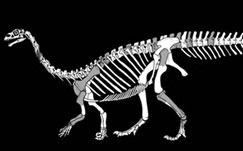New dinosaur discovery in South Africa
24 June 2015
South African and Argentinian palaeontologists today announced the discovery of a
new 200-million-year-old dinosaur from South Africa, and named it
Sefapanosaurus, from the Sesotho word
sefapano.
Found in the 1930s some 30km from the Lesotho border in the Zastron area of the
Free State, it had remained hidden for decades among thousands of fossils in the
largest fossil collection in South Africa at the Evolutionary Studies Institute (ESI) at
the University of the Witwatersrand in Johannesburg.
While visiting the ESI collections to look at early sauropodomorph dinosaurs, Dr
Alejandro Otero, Argentinian palaeontologist and lead author, and a PhD student
from the University of Cape Town, Emil Krupandan, noticed bones that were
distinctive from the other dinosaurs they were studying.
Considered first to represent the remains of another South African dinosaur,
Aardonyx, close scrutiny of the
fossilised bones revealed that it is a
completely new dinosaur.
Distinctive bones
One of the most distinctive features is that one of its ankle bones, the astragalus, is
shaped like a cross. Considering the area where the fossil was discovered, the
researchers aptly named the new dinosaur,
Sefapanosaurus, after the
Sesotho word
sefapano, meaning "cross".
The remains of the
Sefapanosaurus include limb bones, foot bones,
and several vertebrae. It is represented by the remains of at least four individuals
in the ESI collections. It is considered to be a medium-sized sauropodomorph
dinosaur – among the early members of the group that gave rise to the later long-
necked giants of the Mesozoic.
"This find indicates the importance of relooking at old material that has only been
cursorily studied in the past, in order to re-evaluate past preconceptions about
sauropodomorph diversity in light of new data," says
Krupandan.
Scientific collaboration
It also highlights the importance of close collaboration between South African and
Argentinian palaeoscientists.
Dr Jonah Choiniere, co-author and senior researcher in dinosaur palaeobiology at
the ESI, says: "This new animal shines a spotlight on southern Africa and shows us
just how much more we have to learn about the ecosystems of the past, even here
in our own backyard.
"And it also gives us hope that this is the start of many such collaborative palaeo-
research projects between South Africa and Argentina that could yield more such
remarkable discoveries."
The researchers are from South Africa's University of Cape Town and Wits
University, and from the Argentinian Museo de La Plata and Museo Paleontológico
Egidio Feruglio. They made the announcement in a paper, titled: "A new basal
sauropodiform from South Africa and the phylogenetic relationships of basal
sauropodomorphs",
published online in the journal,
Zoological Journal of the
Linnaean Society on 23 June.
Source: Wits
University
 A drawing of the Sefapanosaurus. (Wits University)
A drawing of the Sefapanosaurus. (Wits University)




